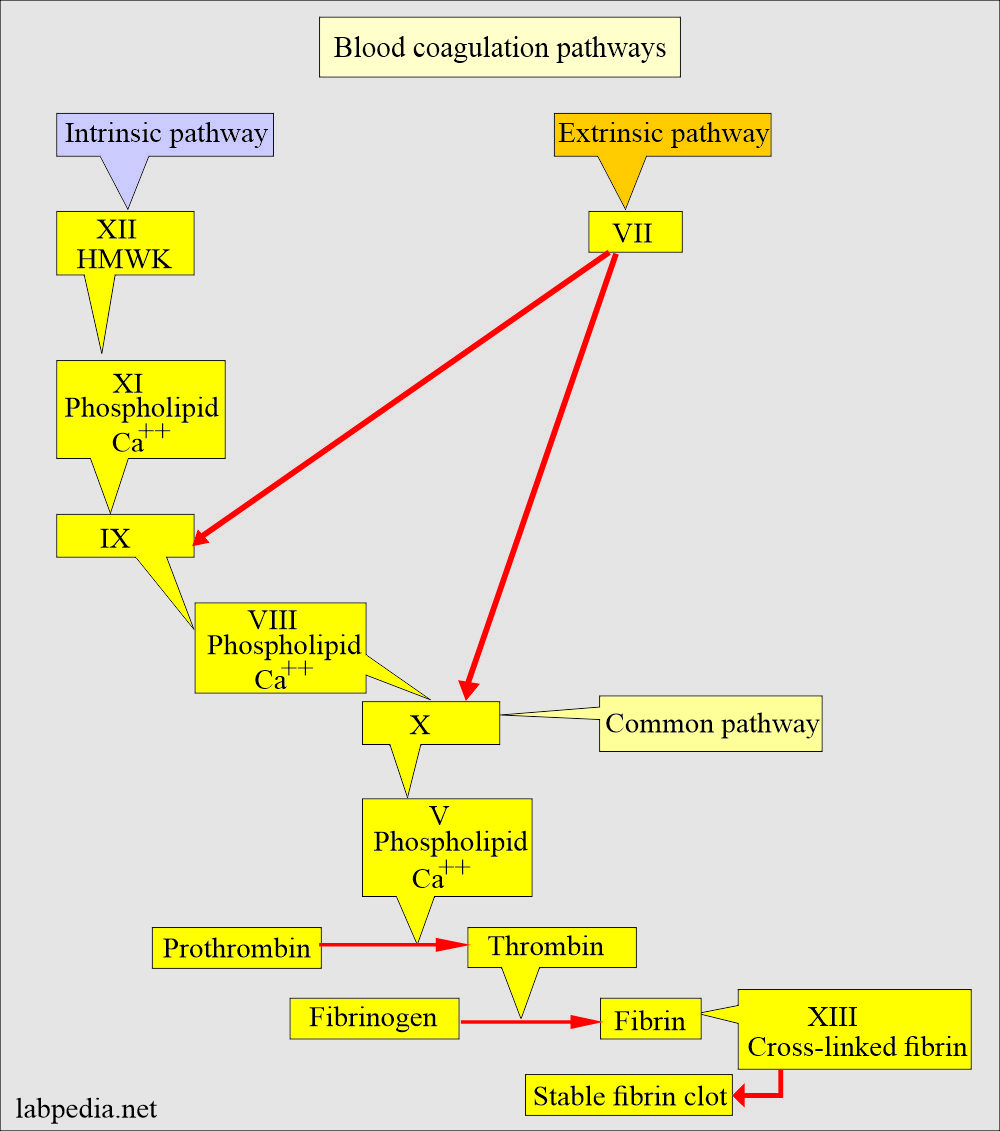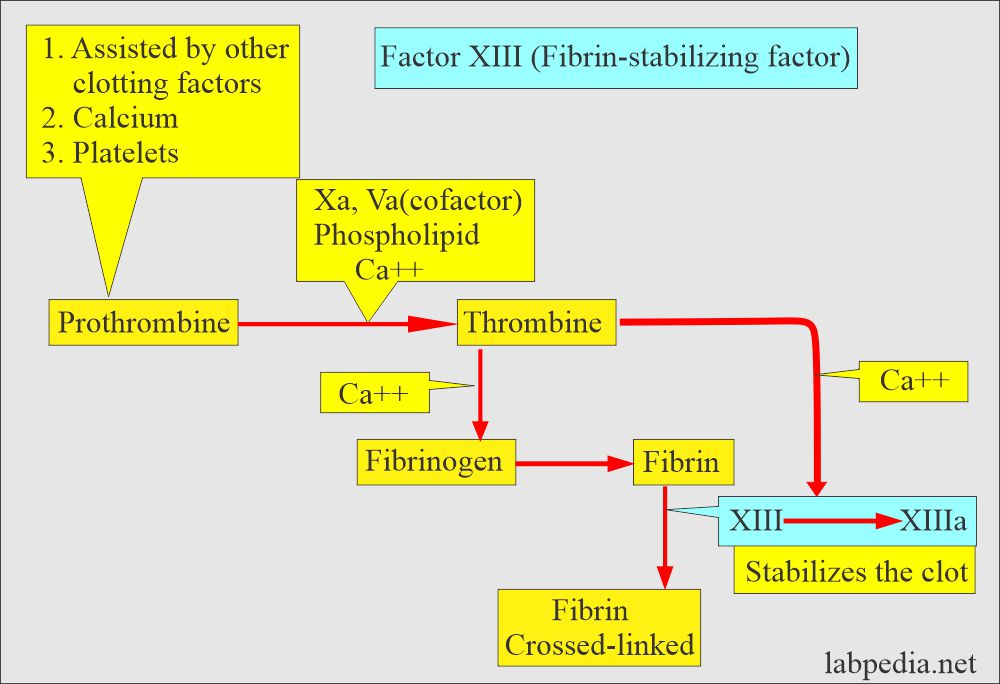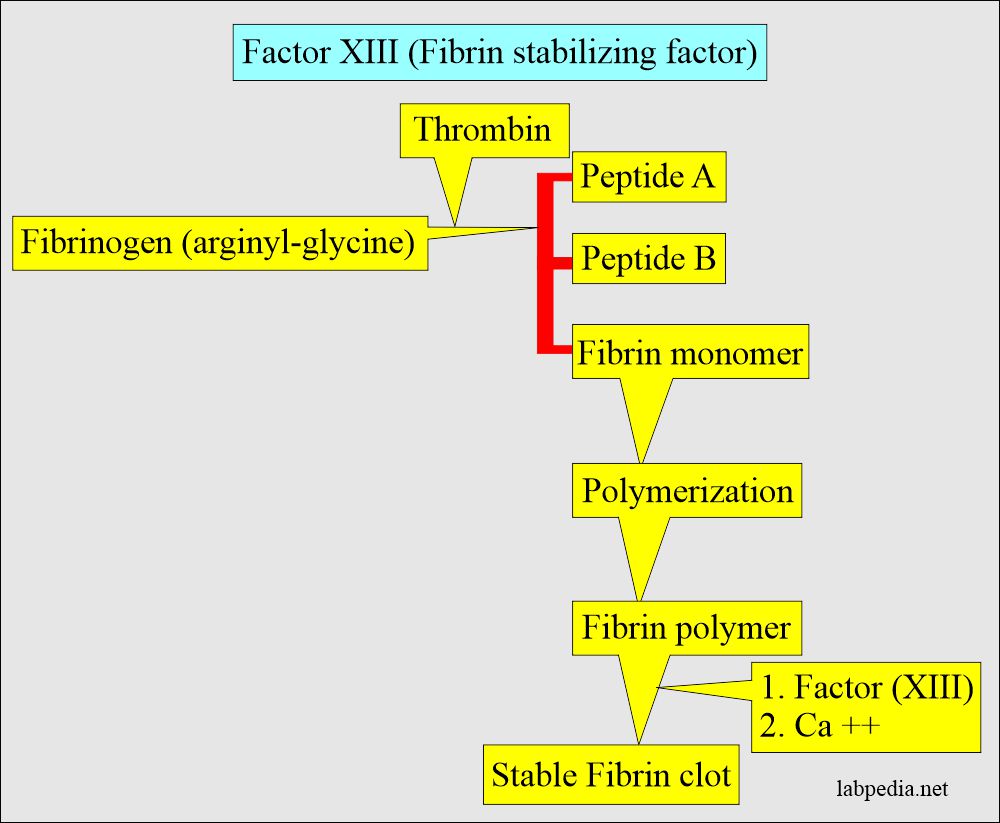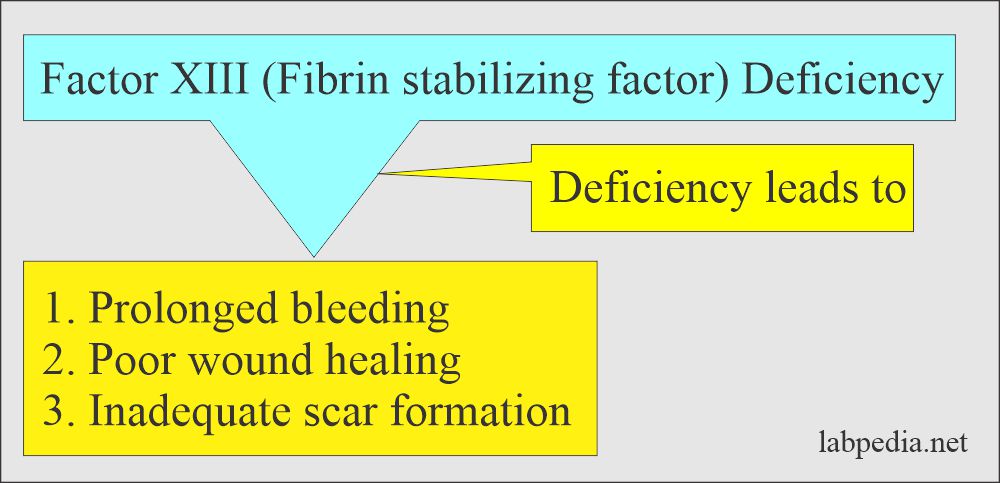Factor XIII (fibrin stabilizing factor)
Factor XIII (fibrin stabilizing factor)
What Sample is needed for Factor XIII (fibrin stabilizing factor)?
- Plasma (Citrate) is needed, and it is stable for 2 hours at 4 °C only.
What is the Indication for Factor XIII (fibrin stabilizing factor)?
- To find the deficiency of factor XIII.
What is the history of fibrin stabilizing factor (XIII)?
- This fibrin stabilizing factor (XIII) was discovered in 1944, and its role was confirmed in 1966.
- It has a crucial role in stabilizing the fibrin clot in the last stage of clotting.
How will you define Factor XIII (Fibrin stabilizing factor)?
- Factor XIII (Fibrin stabilizing factor) stabilizes a polymerized fibrin clot in the presence of calcium in the initial clot stage.
- It is responsible for the cross-linking of the fibrin strands, which will strengthen and stabilize the final clot.
- It does not circulate in the plasma.
Describe the Fibrin stabilizing factor (XIII) structure?
- Factor XIII has a molecular weight of 320,000 daltons and circulates with fibrinogen.
- It consists of two subunits, α2-unit and β2-unit chains.
- Factor XIII is also present in the precursors of platelets, monocytes, and macrophagic cells in the bone marrow.
- Factor XIII has a long half-life of 5 to 9 days.
How will you discuss the Pathophysiology of the fibrin stabilizing factor (XIII)?
- Factor XIII deficiency is congenital and inherited as an autosomal recessive trait with a severe coagulation defect.
- Clinically, the homozygous deficiency has moderate to severe hemorrhagic episodes.
- Factor XIII is present in the plasma, platelets, monocytes, and macrophagic cells.
What are the Functions of factor XIII?
- Factor XIII cross-linked fibrin and other proteins.
- It stabilizes the clot. Its >5% activity is required to form a normal clot.
- The stabilized fibrin clot in factor XIII deficiency becomes insoluble in various substances like urea.
- This factor helps in wound repair and healing.
How will you describe deficiency of factor XIII (Fibrin stabilizing factor)?
- Congenital deficiency:
- It is transmitted as an autosomal recessive trait.
- First, bleeding is noted in newborns.
- In later life, bleeding episodes are mild with severe trauma or surgery.
- Delayed bleeding after trauma.
- Poor wound healing.
- Inadequate scar formation.
- Bleeding is common after separating the umbilical cord in case of factor XIII deficiency.
- A secondary deficiency:
- It may be seen in various conditions:
- Malignancies like AML.
- In liver diseases.
- Presence of circulating inhibitors.
- Associated with hypofibrinogenemia in obstetric complications.
- This type of deficiency is subclinical.
What are the signs and symptoms of XIII (Fibrin stabilizing factor) deficiency?
- Bleeding was first noted in newborns. Later on, bleeding episodes are mild except for severe trauma and surgery.
- There is easy bruising and soft tissue bleeding, which may be due to trauma.
- There may be a severe bleeding tendency.
- The bleeding tendency may be like hemophilic patients; these patients may have hemarthrosis and deep tissue bleeding.
- This bleeding is characterized by the initial stoppage of bleeding followed by the recurrence of the bleeding after 36 hours or more after the initial trauma.
- This resulted from the fibrin clot dissolution that formed in the beginning and was not stabilized by factor XIII.
- Acquired partial deficiency has been reported with a few diseases like leukemia, DIC, and severe liver disease.
- It may lead to spontaneous miscarriage in early pregnancy.
- There may be bleeding from the umbilical cord, which may be from 1 to 9 days of birth.
- It may lead to CNS hemorrhage, which is quite common. This may be the first symptom.
- Patients with CNS hemorrhage may have headaches, vomiting, seizures, and focal neurologic defects.
- Some of the females may have intra-abdominal bleeding during menses.
- There will be bleeding into the joints (hemarthrosis).
- There is poor wound healing.
What is the Normal Factor XIII (Fibrin stabilizing factor)?
- Plasma concentration = 2.5 mg/dl.
Source 1
- The test is negative with factor XIII above the minimal hemostatic level of 0.02 to 0.05 U/mL (x1000 = 20-50 U/L).
- OR 2% to 5% (x0.01 = 0.02 to 0.05, fraction) of normal concentration.
- The clot will be stable for 24 hours with factor XIII above the hemostatic level.
- In the absence of factor XIII, the clot will dissolve, often within 2-3 hours or less.
How will you do Lab diagnose of factor XIII deficiency?
- PT, APTT, fibrinogen, bleeding time, and platelet count are normal.
- All these parameters may be normal in congenital deficiency.
- The clot is soluble in 5 Molar urea solution, which will not occur in a normal person.
- A whole blood clot is qualitatively friable.
How will you describe the Factor XIII screening test?
- In factor XIII deficiency, coagulation tests are usually normal.
- The other coagulation tests do not detect the deficiency of factor XIII.
- The minimum level required for factor XIII is about 5%.
- Principle of the test:
- Stabilization of the clot is dependent on factor XIII.
- The clot is soluble in 5 M urea.
- In the test after 24 hours, the presence of a formed clot indicates plasma factor XIII concentration greater than 1% to 2%.
- In the homozygous deficiency of factor XIII, the fibrin clot dissolves within one hour and indicates a deficiency of less than 1%.
- Stabilization of the clot is dependent on factor XIII.
How will you Treat factor XIII (Fibrin stabilizing factor) deficiency?
- The following blood substitutes can be tried.
- Fresh frozen plasma.
- Cryoprecipitate.
- Factor XIII concentrate.
- Factor XIII recombinants.
Questions and answers:
Question 1: What are the lab findings in factor XIII deficiency?
Question 2: What are the complications of factor XIII deficiency?





